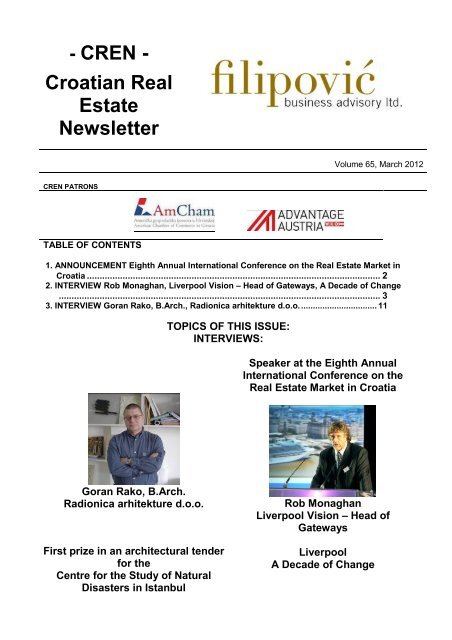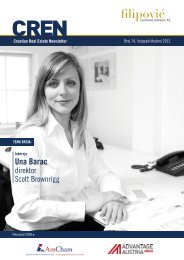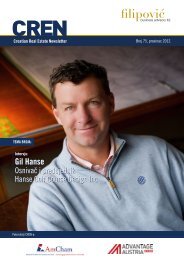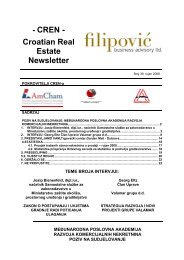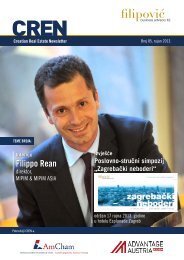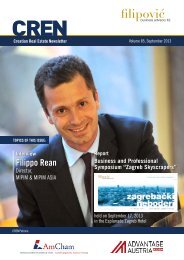- CREN - Croatian Real Estate Newsletter
- CREN - Croatian Real Estate Newsletter
- CREN - Croatian Real Estate Newsletter
You also want an ePaper? Increase the reach of your titles
YUMPU automatically turns print PDFs into web optimized ePapers that Google loves.
- <strong>CREN</strong> -<strong>Croatian</strong> <strong>Real</strong><strong>Estate</strong><strong>Newsletter</strong>Volume 65, March 2012<strong>CREN</strong> PATRONSTABLE OF CONTENTS1. ANNOUNCEMENT Eighth Annual International Conference on the <strong>Real</strong> <strong>Estate</strong> Market inCroatia ................................................................................................................... 22. INTERVIEW Rob Monaghan, Liverpool Vision – Head of Gateways, A Decade of Change.............................................................................................................................. 33. INTERVIEW Goran Rako, B.Arch., Radionica arhitekture d.o.o................................. 11TOPICS OF THIS ISSUE:INTERVIEWS:Speaker at the Eighth AnnualInternational Conference on the<strong>Real</strong> <strong>Estate</strong> Market in CroatiaGoran Rako, B.Arch.Radionica arhitekture d.o.o.First prize in an architectural tenderfor theCentre for the Study of NaturalDisasters in IstanbulRob MonaghanLiverpool Vision – Head ofGatewaysLiverpoolA Decade of Change
1. ANNOUNCEMENT Eighth Annual International Conference on the <strong>Real</strong><strong>Estate</strong> Market in Croatia<strong>CREN</strong> - <strong>Croatian</strong> <strong>Real</strong> <strong>Estate</strong> <strong>Newsletter</strong>/ March 2012 2
2. INTERVIEWRob MonaghanLiverpool Vision – Head ofGatewaysA Decade of ChangeSpeaker at the Eighth AnnualInternational Conference on the <strong>Real</strong><strong>Estate</strong> Market in CroatiaLiverpoolA Decade of ChangeCould you please introduce yourself to<strong>CREN</strong> readers?After a number of years in the privatesector, I have spent the last 15 yearsworking in Liverpool in the field of urbanregeneration. Initially working for EnglishPartnerships, then the NorthwestDevelopment Agency, both sub-regional,public sector economic regenerationagencies, then ultimately moving into aprivate sector special purpose vehicle todeliver economic regeneration inLiverpool. Educated to degree level inUrban <strong>Estate</strong> Management and latterly aMasters course in Urban Renewal, I amcurrently Head of Gateways at LiverpoolVision. Married with two grown upchildren, I live, work and play in SouthLiverpool!Liverpool is a city on the up. How didthe project “changing city” start?Liverpool’s renaissance is of internationalsignificance. The city delivered anambitious 20 year regenerationprogramme for the City Centre in under adecade. £4 billion of investment hastransformed its retail offer, supply of highquality office and hotel space and thevisitor experience. Developmentprogrammes in the city’s Gateway areashave supported this, providing high qualitycommercial space and improvedconnections to national and internationalmarkets, through the thriving LiverpoolJohn Lennon Airport. The overall effecthas been dramatic: in the last decadeLiverpool’s growth has been faster thanthat of any other city in the UK, outsideLondon. Liverpool’s year as EuropeanCapital of Culture in 2008 and awardwinning presence at the World Expo inShanghai in 2010 put the city on the worldstage once again. These major successstories reflected Liverpool’s growingconfidence and helped transformperceptions of the city, which nowgenerates £1.7m of economic impact fromvisitors and tourism.Perceptions of the retail offer continue toimprove, with 96% of people rating it as‘good’, up 37% since 2007. Liverpool’sGVA was £8,767m in 2009 - almost 45%of the Merseyside total, showingremarkable resilience during the start ofthe economic downturn. Forecasts identifythe scale of the City Region’s growthpotential, including the creation of anadditional 60,000 jobs by 2022. The<strong>CREN</strong> - <strong>Croatian</strong> <strong>Real</strong> <strong>Estate</strong> <strong>Newsletter</strong>/ March 2012 3
current economic circumstanceschallenge that timescale, but currentLiverpool aims to fulfil its potential andbecome a world capital for growth andentrepreneurship.Liverpool CentrePlease introduce Liverpool Vision.What is the company's mission?Clarity of purpose characterises highperforming organisations. LiverpoolVision’s purpose is clear: to boostLiverpool’s economic growth. This will bemeasured in terms of Gross Value Added[GVA]. Increasing GVA is an indication ofthe level of job, investment and wealthgrowth, providing an appropriate measureof the overall health of Liverpool’seconomy and Liverpool Vision’s overallsuccess. All of Vision’s activities and thesystems that support them are designedto serve this purpose, including creatingjobs. This contributes directly to LiverpoolCity Council’s corporate aim to makeLiverpool the preferred choice forinvestment and job creation, and its visionof ‘Liverpool as a distinctive global city’.Vision boosts economic growth byintervening in the market, supporting theprivate sector to deliver new jobs andinvestment. The nature of theinterventions has shifted in recent yearsand continues to do so, due to reducingpublic spending patterns, newGovernment policies and the drive forincreased efficiency. For much of the lastfifteen years significant public spendingwas used to fund direct interventions inboth the supply and the demand sides ofthe market, supporting the market byinvesting in, and encouragingdevelopment and inward investment. Thiswas supported by indirect activities tocoordinate supply and promote demand,but the scale of the resources deployed todirect interventions was central to theapproach. The continuing reduction ofpublic sector spending funding means thatdirect intervention in the market is onlypossible at a greatly reduced scale,targeted at providing carefully selectedevents. The centre of gravity has shiftedtowards indirect interventions, involvingcoordinating the provision of supply andstimulating demand through marketingand investment facilitation.Do you have partners in project“changing city”?Successful intervention in the localeconomy requires coordinated actionacross a range of issues involving manypublic and private partners. Vision isworking with the City Council to developan economic masterplan that sets out howthis will be achieved over twenty fiveyears. The City Council (with partners) isleading overall, with specific responsibilityfor the transport, education, employment,skills and worklessness agendas,including neighbourhood regeneration.The Council’s Regeneration team will leadon physical development. Liverpool Visionis leading the delivery of key economicelements of the masterplan, includingdeveloping priority growth sectors,supporting infrastructure and coordinatingintervention in the City Centre and NorthLiverpool. It is also leading on the city’sbrand and marketing, through theLiverpool Plan, and has an increasing rolein Culture and Tourism.<strong>CREN</strong> - <strong>Croatian</strong> <strong>Real</strong> <strong>Estate</strong> <strong>Newsletter</strong>/ March 2012 4
The Priority Investment Areas of theproject are City Centre, Northshore,Eastern Approaches, InternationalGateway and Approach A580 Gateway.Tell us something about theseprojects.1. City Centrelong term vision and aspiration for thearea is presented in detail in theestablished North Liverpool and SouthSefton Strategic RegenerationFramework. Partner interventions arefocused on the delivery of a number oftransformational actions and a coordinatedactivity in the three key themesof developing People, Place andProsperity, linked to the StrategicRegeneration Framework.Liverpool City Centre is at the heart of theCity Region’s economy; it has beentransformed over the last decade andcontributes over half of Liverpool’seconomic output and just under half of itsjobs. The City Centre also has a strongand growing cultural offer, including morelisted buildings than any city in the countryoutside Westminster and cutting edgenew developments including the Museumof Liverpool. Over the next 10-15 yearsthe City Centre will be consolidated andextended to the north, developing from thealready growing Commercial District,linking to the Liverpool Waters. This willprovide the basis for significant growth,supported by developments designed tostrengthen other priority locations, sectorsand supporting infrastructure, includingsuperfast broadband.2. North LiverpoolNorth Liverpool presents an economicopportunity of national significance. It islocated immediately adjacent to LiverpoolCentre and the Liverpool Enterprise Zone,with seven kilometres of underutilisedwaterfront extending to the Port ofLiverpool to the north. The location offerssignificant potential for growth, with theextension of Liverpool City Centre throughthe City Fringe area and Peel’s landmarkLiverpool Waters development. This willbe reinforced by the development of thePort of Liverpool with a post PANAMAXfacility, and projects planned in the areafocused on low carbon, and the retail,cultural and visitor offer. The ambitious3. Eastern Approaches (Edge Lane)The Edge Lane Project comprises morethan just a highway improvement scheme,but is the name given to a collection oflinked physical regeneration projects. Theprojects are linked by the spine of EdgeLane - which will deliver a new andattractive environment, new homes, newbusiness space, new retail and leisurefacilities and a transportation link from theend of the M62 to the City Centre worthyin every respect of a major European City.Vision is charged by its Board to promoteand manage the delivery of the EdgeLane Project working in close partnershipwith key private sector developers andpublic sector funders and in closepartnership in particular with LiverpoolCity Council. The seven component partsof the project are:• Edge Lane Highway Improvements• Rocket Environmental Improvementsand Public Art• Edge Lane Retail Park• Villas Site• Liverpool Innovation Park• Littlewoods/JCM Building• Edge Lane West RegenerationProject.These elements are knitted together indesign terms by Vision’s Design Panelwhich will ensure continuity and a highstandard of design and build.The objective of this project is the creationof a new urban boulevard and the removal<strong>CREN</strong> - <strong>Croatian</strong> <strong>Real</strong> <strong>Estate</strong> <strong>Newsletter</strong>/ March 2012 5
of bottlenecks to upgrade the highway onLiverpool’s primary arterial route forvehicular traffic. As well as the highwayimprovements, six economic developmentprojects are being brought forward alongthe corridor which will begin to increasethe economic performance of this part ofthe city. The Project will transform theroute and create an environment whichreflects the aspirations and status ofLiverpool as a major European city. It willbe a key component in developingEastern Approaches as a vibrant anddynamic area and to exploit the hugeemployment growth potential.4. International GatewayThe South Liverpool InternationalGateway is located at the southern end ofthe Liverpool conurbation. It covers anarea of approximately 1,613 hectares(6.22 square miles) and encompasses thecommunities of Speke, Garston and HuntsCross. It is commonly recognised as theemployment area alongside SpekeBoulevard, extending from as far as theMersey Wave at Halewood to GarstonDocks.The International Gateway is one of fiveStrategic Investment Areas in Liverpooland is recognised for its economicimportance not only to the City ofLiverpool, but the wider Liverpool Citysub-region and North West England(between 2005 and 2008, some 5,000new jobs were created here, bringing thetotal to above 20,000). Major employersinclude Jaguar / Land Rover, Eli Lilly,Novartis, the National Bio ManufacturingCentre and Shop Direct, but mostspecifically it is home to Liverpool JohnLennon Airport, defining the importance ofthe International Gateway as an integraland complementary part of the City and akey economic driver.Since 1996, a major public-sector-ledregeneration programme has promptedsignificant enhancements to the area,leading to a surge in inward investment,but there are still areas of derelict andvacant land. Liverpool Vision is chargedby its Board to promote and manage thecontinued economic regeneration of theInternational Gateway, working in closepartnership with key private sectordevelopers and public sector funders.A Strategic Regeneration Framework(SRF) has recently been realised for theInternational Gateway. The SRF providesa comprehensive development frameworkfor the area so that there is a clearpurpose and direction for developmentwithin South Liverpool over the next 15-20years. The SRF identifies thedevelopment drivers for the area and indoing so proposes a strategy in which tochannel land uses and physicalimprovement within the InternationalGateway, encapsulated in the followingvision statement:“South Liverpool International Gatewaywill play a pivotal role in the sustainableeconomic development of the LiverpoolCity Region as one of the UK’s primaryinternational gateways and a thrivinginternational city.Building from the area’s establishedreputation for high quality businessinvestment, its landscape setting and itsinter-modal, international and interregionaltransport links, it will fulfil its potential as adynamic and enterprising destination,which is a great place to visit as much asa place to live and work.South Liverpool International Gateway willbe the focal point for major economic andresidential development in SouthLiverpool, offering the quality ofenvironment and infrastructure thatenables the businesses and communitiesof Speke, Garston and Hunts Cross toachieve their full potential.”In order to spatially reflect the aspirationsof the vision, the SRF provides a land useframework set within a strategicallyplanned network of high quality walking<strong>CREN</strong> - <strong>Croatian</strong> <strong>Real</strong> <strong>Estate</strong> <strong>Newsletter</strong>/ March 2012 6
and cycle routes, green spaces and otherenvironmental and recreational features.These have informed a series of AreaDevelopment Frameworks for the subareasof the International Gateway, whichin turn has led to the identification offuture development projects that will meetthe long term objectives of the SRF.The Gillmoss area has been characterisedby a bleak concrete public realm, poorquality housing, and unattractive vacantland. Work is almost complete on theremodelling of 30ha of land to the north ofthe A580 to produce a quality businessenvironment at Stonebridge Park.However, the complimentary retail,residential and leisure development to thesouth of the highway has stalled duemainly to market conditions and lack ofdirection.Mersey Wave5. Approach A580 GatewayThe Approach 580 Gateway is situated 9miles northeast of Liverpool City Centre.The Gateway comprises of a series ofestablished employment areas, withsignificant development opportunitiesalong the strategic A580 East LancashireRoad that links North Manchester and theM57 to Liverpool City Centre. The two keyareas requiring Liverpool Visionsintervention are Aintree Industrial <strong>Estate</strong>and the Gillmoss area where there are arange of commercial, retail and residentialopportunities located on the A580frontage.Aintree Industrial <strong>Estate</strong> is an ageing butimportant concentration of industry that ishome to over 100 predominantly smallbusinesses and provides a pay packet forover 5,000 people. However, its buildingstock and environment are poor and as aconsequence the estate is not fulfilling itspotential. Liverpool Vision has instigated arebranding of the estate, along with twophases of public realm improvements;however, there is a need to carry out afurther two phases to complete thestrategy.You are working on the project -approach A580 Gateway. What are thebiggest challenges you are facing inthe project?A major project on the A580 Gateway isStonebridge Cross at 98-acres, one of thelargest council-owned development sitesin the city. There were plans before therecent property crash to bring forward amixed use, retail and housingdevelopment on the site; however, due topoor market conditions this project stalled.There was a need therefore to look atdifferent ways of delivering such a largedevelopment site.The Stonebridge Cross StakeholderGroup was set up to drive forward thecommunity-led redevelopment of the site.Following extensive consultation, thepreferred option for a comprehensive,mixed-use development was endorsed bythe group in 2010 and these ambitiousplans will be delivered by the council’sgroundbreaking ‘asset-backed vehicle’,called Inliverpool, which sees the councilprovide the land and private sectorpartners paying for and delivering theproject.The long-awaited multi-million poundtransformation of the run-down estate isabout to become a reality. Demolitionwork is underway and paves the way for a£200 million regeneration scheme whichwill revitalise the area. The Stonebridge<strong>CREN</strong> - <strong>Croatian</strong> <strong>Real</strong> <strong>Estate</strong> <strong>Newsletter</strong>/ March 2012 7
Cross scheme will deliver 500 newhomes, new retail and commercialdevelopment and a new park. Plans forthe site, which was once occupied by theGillmoss estate, also include therelocation of St John Bosco School and anew health centre. The start of thedemolition work is a major milestone forlocal residents, who have seen a numberof proposals for the area fall by thewayside in recent years. This investmentin Stonebridge Cross is long overdue, andit is one of the key regeneration schemestaking place in Liverpool over the nextthree years that will benefit thousands ofpeople for generations to come.Stonebridge ParkIs any of projects within “changingcity” in final stage (latest phase ofcompletion)? Are any of the projectscompleted?Probably the two most successful projectsin Liverpool over the past decade areLiverpool One and the new Waterfront.Liverpool‘s retail landscape has changeddramatically since the opening ofGrosvenor’s Liverpool ONE developmenton 2008. Grosvenor’s £1bn Liverpool Oneproject is the largest retail-ledregeneration project in Europe. Thescheme, covering 42 acres provides 1.5msq ft of retail space as well as hotels,apartments, a multi-screen cinema andrestaurants. Liverpool One, together withthe Met Quarter feature stores previouslyabsent from the city such as Debenhams,Hugo Boss, Armani, Esprit, L’Occitane,Henri Llloyd, Swarovski and Wagamama.Since its inception in 2008 Liverpool ONEhas catapulted the city to the 5th biggestretail city in the UK, up from 15th theprevious year. The public realm within theretail area has benefitted from significantinvestment upgrading the quality of theentire retail centre.Over the past five years the regenerationof Liverpool’s city centre waterfront hasbecome a reality, with the development ofa number of major schemes helping totransform the area into a major visitordestination.At Kings Waterfront, the Liverpool EchoArena – which launched the city’sEuropean Capital of Culture celebrationsin January 2008 – and the BT ConventionCentre have hosted a series of high profilenational and international events andconferences.At Albert Dock, an extensive programmeof environmental and infrastructureimprovements – including new lighting,signposting and pedestrian access – isimproving the destination offer.Perhaps the most dramatic transformationis at the Pier Head. The City of LiverpoolCruise Liner Terminal opened inSeptember 2007 and is already attractingvisits from some of the largest liners onthe European circuit. The Leeds -Liverpool Canal Link, opened in April2009, provides unbroken access fornarrow boats to newly constructed berthsin the south docks. The Mersey FerriesTerminal – including a cafe, restaurant,4D cinema and Beatles Story exhibition –was formally opened in July 2009.The public space at the Pier Head publichas been completely remodeled, with twosheltered basins overlooking the canalproviding an attractive area for sitting out.Adjoining the Pier Head at Mann Islandwork is nearing completion on the newMuseum of Liverpool, scheduled to openin July 2011. The mixed use developmentby Countryside Neptune is well underwayon all three buildings at Mann Island. The<strong>CREN</strong> - <strong>Croatian</strong> <strong>Real</strong> <strong>Estate</strong> <strong>Newsletter</strong>/ March 2012 8
first phase was completed in Spring2010.Warefrontproviding high-quality buildings forcompanies in these sectors.The former Speke Garston DevelopmentCompany initiated £15 million worth ofreclamation work on the 65 acre site in1998 with preferred developer Intercity(now UK Land and Property) inpreparation for the development of up to93,000 square metres of new industrialand commercial space. The infrastructurecontract included site preparation, theinstallation of sewers and the provision ofutilities, access roads and landscaping.Boulevard Industry Park has so farattracted £100 million of new investmentand almost 1,000 jobs in the followingbusinesses:Liverpool Echo ArenaYou have many years of expertise inregeneration of the city. You have leadon some of the biggest infrastructureprojects in Liverpool including thetransformation of old automotivecluster into to one of the mostadvanced plants in the UK and havealso helped to shape out Pharmacycluster in the South of the city. Tell ussomething about the project.Although just outside of the Liverpoolboundary, Jaguar Land Rovers (JLR)facility at Halewood is a hugely importantpart of the local economy and theworkplace of many of the residents ofSouth Liverpool. South Liverpool is alsohome to a significant biopharma sector.Speke Halewood has long been a centreof excellence for both the automotive andbiopharmaceutical industries, andBoulevard Industry Park was conceivedwith the aim of building on this success by• Evans Medical, who expanded theirexisting adjacent site at GaskillRoad onto the park with twophases including a new researchand development facility totalling£44 million and creating 320 newadditional jobs. Evans wassubsequently acquired by Chiron,and more recently Chiron has beentaken over by Novartis. TheNovartis plant, today employs over700 people, and makes Fluvirin, atriple-antigen flu vaccine, approvedfor sale in more than 20 countries;• MedImmune who focus on usingbiotechnology to produceinnovative products and fluvaccines. Their plant employs 130people;• Merplas (originally the US-basedConix Corporation) who employ100 people in a £20 million plantmanufacturing bumpers andassociated exterior products for thenearby Ford Jaguar plant;• Lear, another US-based companywho employ 115 people making150,000 car seats per annum;• Visteon, who invested £4.2 millionin a 7,000 sq m facility creating 70jobs making car instrument panels;<strong>CREN</strong> - <strong>Croatian</strong> <strong>Real</strong> <strong>Estate</strong> <strong>Newsletter</strong>/ March 2012 9
• Car assemblies and pressingsfirm Stadco, who invested £3million in a new manufacturingfacility which now employs 50people;• Coughlin Logistics - part ofMichigan-based FX Coughlin - whoservice the adjacent factory of seatmanufacturer Lear but has thepotential to meet the requirementsof other customers as well;• Birmingham-based car fasteningsfirm Infast who invested £1.8million in a new 2,500 sq m facility,creating more than 40 jobs; and• Powderject Pharmaceuticals whoinvested a further £70 million in itsSpeke operation before beingtaken over by Novartis.None of this investment would have beenpossible had it not been for the early inputby the public sector to improve theenvironment; acquire, remediate andservice sites for the private sector toinvest.<strong>CREN</strong> - <strong>Croatian</strong> <strong>Real</strong> <strong>Estate</strong> <strong>Newsletter</strong>/ March 2012 10
3. INTERVIEWGoran Rako, B.Arch.Radionica arhitekture d.o.o.First prize in an architectural tender for theCentre for the Study of Natural Disasters in IstanbulCould you please introduce yourself toour readers?I am an architect who has been in thisbusiness for 35 years now, with a certainamount of fanaticism. I believe that this isthe only way you can engage inarchitecture, and still care about theresults you achieve.The first tender I participated in was theone I prepared with Miloš Pecotić, whowas later to become the best man at mywedding, but at that time we were bothjust students. We designed the Battle ofNeretva Museum in Jablanica. Based onthe name of the museum, I’ll let youconclude for yourselves when this was.Besides being an architect who has beenengaged in architecture for 35 years, I amalso a professor at the Faculty ofArchitecture in Zagreb, where I have ledcourses in design for about ten years now.For a while, I worked with students onkindergartens and schools, now I ammore into hotels, but I am inclined to saythat all this is one and the same task. Forme, there is no difference betweendesigning an apartment and designing acity. These are very similar things.Which projects would you mention asthe most important throughout yourcareer?The most important projects are those thatare implemented, and those, by whichyour work is recognized. The mostrenowned ones are projects, such as theNarona Museum in Vid near the town ofMetković, and now my most recent projectin Istanbul. I would also like to mention theproject in Japan, as some 20 years ago,Bojan Radonić and I won an award for theCongress Centre in Nara. So, these arejust some of the numerous projects wehave worked on. This is like an iceberg,only one eleventh shows above the watersurface. There are numerous projects,which we are very fond of, but they neverappeared in the public, nobody saw them,nobody recorded them.There are at least ten projects, for whichwe were convinced that they would beimplemented, but the circumstances in thecountry where we live are such that youcan never really count on that happening.Today, I have become somewhat“immune” to that, I stick to the old Romanmotto: “cum grano salis”, I just observewhat is happening and I knock on wood.We don’t know what will be, nobodyknows that.<strong>CREN</strong> - <strong>Croatian</strong> <strong>Real</strong> <strong>Estate</strong> <strong>Newsletter</strong>/ March 2012 11
Recently, you and your team won firstprize in an international tender.Could you please present the wholeproject team and tell us more aboutthat project.Who were the competitors? What wasthe crucial element why your work wonthe award?This is a project of the Centre for theStudy of Natural Disasters in Istanbul.The project team consisted of six people.From our office, there were: Iva Pejić,Josip Sabolić and myself, and threestudents: Sara Jurinčić, Iva Peručić andAna Rako. The students were just asproactive as the experienced architects -naturally, under our mentorship. Wecorrected them, guided them in the rightdirection, but obviously it was the rightdirection already, otherwise we would nothave won the contest.The Project Team for the Centre for the Study of Natural Disasters in IstanbulHow was the project conceived fromthe concept design to the finalproduct?The architecture our office produces ischaracterized by the fact that we work onthe basis of the location and the taskgiven to us. We take into account all thepossible elements of the context, in whichsomething is happening. So, this Istanbultask was specific, primarily because it wasabout the city of Istanbul. First of all, thisis a wonderful city, and it is incredibly wellsituated: magnificent nature and incrediblybeautiful architecture, such as the HagiaSophia, the Bazaar and a whole range ofother buildings, which are exceptionallyvaluable in architectural terms.However, the place where the Centre forthe Study and Prevention of NaturalDisasters is located, is a very “ugly”location. It is near the Ataturk airport,surrounded by shopping malls and tallbuildings. This is a part of the city whereyou would not know that you are inIstanbul. All huge cities in the world, withabout 20 million inhabitants, such asIstanbul, have neighbourhoods such asthis one. So, it is quite an inarticulate andmessed-up part of the city, with no specialidentity. We concluded that we would dosomething in the opposite direction. Thatin this “forest” of tall buildings andshopping malls, we would make a onestoreybuilding surrounded by a largepark. In Zagreb, you could compare this tothe Botanical Gardens. We decided thatwe would not compete with the big skyrises,but make a botanical garden. Wesurrounded the botanical garden with ahouse, and made it into some kind ofprivate park: a park surrounded by ahouse, which could be best compared tothe athletic track at a stadium. A fourhundred meter corridor with adjoiningclassrooms, halls, restaurants, cafeterias,tsunami centre, earthquake centre, lecturehalls etc. All this on this “track”surrounding the park. Given that it is aone-storey building, at any point in timeyou can go out in the park, beneath the<strong>CREN</strong> - <strong>Croatian</strong> <strong>Real</strong> <strong>Estate</strong> <strong>Newsletter</strong>/ March 2012 12
trees, in the shade, or go to the ponds,flower-beds, orchards. We wanted toprovide something quite contrary to theother buildings that exist in that part of thecity, to build something that is lackingthere. The building plot used to be a largeparking lot, a huge amount of asphalt thatwe are turning back into a park, intosomething that it used to be some fiftyyears ago – agricultural land or anorchard. We are giving it back the functionit used to have. Naturally, this is no longerthe place it used to be, but thecharacteristics are clear, it ought to be acontrast to its surroundings. Now when Iam reading the text we wrote, I feel that itwas almost rude and impertinent. Wewrote that this part of the city was sounattractive that we wanted to ignore it.Later on, we realized that the jury includedthe mayor and the departments of the citygovernment who surely participated in thedesign of that part of the city, and we wereso impertinent and insolent. However, itdid not affect our results: proposals weresubmitted by 287 teams from all acrossthe world. There were ten designs in thefinal, and three awards were given. The<strong>Croatian</strong> team won the first prize, theSwiss came second, and the third prizewent to an architect from Lebanon. It isinteresting that there were no Turkisharchitects amongst the first 10, and thejury consisted of seven architects andexperts from Turkey.It is also very interesting, and we wereglad to hear, that the mayor of Istanbul isan architect by background. We supposethat if it had not been so, this tender wouldhave never been an international publictender. It was clear that the mayor ofIstanbul cared very much about what hiscity will look like, and he knew how to getthe best ideas. It is like having an opera ora ballet in your city, and bringing the bestballet dancers from Russia. So, weproduced something that we are certainlyproud of. And the international juryrecognized this. Besides the sevenexperts from Turkey, three jury memberswere from Spain, one from Portugal, onefrom France and one from Egypt.The current appearance of the location of the future Centre for the Study of Natural Disasters inIstanbul<strong>CREN</strong> - <strong>Croatian</strong> <strong>Real</strong> <strong>Estate</strong> <strong>Newsletter</strong>/ March 2012 13
Visualization of the future Centre for the Study of Natural Disasters in IstanbulTo what extent does building practicein Turkey differ from that in Croatia?The practice differs to the extent that thereis a lot of building activity in Istanbul, andalmost none here. Unfortunately, this isthe main difference. Foundations, heatingand the rest – it is the same here andthere, there are no big differences. Thetechnology is not on any different levelthan here. For certain know-how aboutair-conditioning, and maximum use ofnatural resources, which is one of thegoals of this building and of our project,we will certainly have to take advisors whohave much more practice than we do. TheSwedes and the Danish have much morepractice in using solar energy, althoughthey don’t have nearly as much sunlightas Croatia does. So, for using solarenergy, we will seek help from the north.The issue of earthquakes in Istanbul isconstantly active, and it is something thatis expected, it is not the matter of somedistant future, but the citizens simply livewith that every day...Yes, they live with that, and it can be feltin discussions with them. Expectingearthquakes is part of their lives. So,among other things, there is a need tobuild such a centre. No city in the worldhas a centre that studies natural disasters.There are centres in Japan that study onlyearthquakes, there are some similarcentres in the USA and in some otherplaces, but there is no centre that studiesnatural disasters in general. And amongother things, we even added the study ofnuclear disasters.Do you have experience inimplementing projects in foreigncountries?Unfortunately not. This is our secondproject, where we are nearing theimplementation stage. The first time wasin 1992 when Bojan Radonić and Idesigned the Congress Centre in Nara,Japan, and we were among the five finalprojects from 644 designs from all acrossthe world. Our design was among the fivebest rated works, but we were notfortunate enough to be selected as theproject that would be built. It was a niceexperience, we spent seven days inJapan, we had an exhibition in New York,so altogether a beautiful experience, butwe did not implement it. Now it’s Istanbul,then what next?! We’ll see. Working inCroatia, I have learnt to be sceptical,however, I have also seen that somepeople believe in stereotypes aboutIstanbul, quite twisted stereotypes basedon the soap operas filmed there. Istanbulis a global capital with about twenty millionpeople, a city with a metro, and all thepossible elements that any such a largecity has.<strong>CREN</strong> - <strong>Croatian</strong> <strong>Real</strong> <strong>Estate</strong> <strong>Newsletter</strong>/ March 2012 14
What is your opinion aboutinternational city planning andarchitectural tenders in Croatia? Doyou expect more projects to beimplemented by foreign architects inCroatia in the years to come?A tender is certainly the best way to get tothe best project. The best design work byarchitects is the work they do for tenders.In Croatia, it is common for some thirty orforty designs to be submitted for a tender,and at least ten are good quality designs.When it comes to international tenders,there can be as many as 300, 400 or 500competing works. In order to be the best,you have to do the best design you can,and even better than that. You have to dosomething that you have never donebefore.In international tenders in Europe, youalways come across the same names. So,a practice was introduced, that invitationsfor the submission of bids are sent out,and the investors and the cities almostregularly invite the already wellestablishedarchitectural offices. In myopinion, this is bad practice, especially forus who are small in comparison to theseoffices that have several hundredarchitects. In such conditions, thecompetition between an office with fiveemployees and the one with a thousandemployees is difficult. In addition, it isexpected that you prove the financialviability of your company, to prove thatyou can keep up with some of these largeprojects. All this proves that it isexceptionally difficult to get to the forefrontalongside the big European offices thatmostly win such tenders.Do you have any architectural models?I have many models. I have specialpeople that I “adore”, and I follow whatthey do, and I have special buildings. Forinstance, I have been to Istanbul threetimes, and each time I visited the HagiaSophia. This is the best example of acovered hall in the world. The HagiaSophia is still more impressive than evenall the new stadiums and halls. It is builtcompletely of stone, and it looks more likea covered square than a building. It is trulyamazing. Also, when we speak ofIstanbul, I have to mention their Bazaar.The Bazaar is the best shopping centre inthe world, with the best shopkeepers inthe world. Today, it is impossible to inventsomething new, except maybe as a formof kitsch, that could be a more efficientand more functional than the Bazaar interms of a shopping centre. Naturally, youcan provide it with better lighting, airconditioning,you can modernize it. So,architecture is fortunate, because youdon’t have to be trendy all the time. Youcan be at the same time new andtraditional.Monument protection is a veryimportant element in a vast number ofprojects that are being implemented inhighly urbanized locations. Youdesigned the restoration of the Eltzcastle. What were the greatestchallenges in that project, and how didthis design process go?The project team included Ana Boljar,Aleksandra Duka, Blanka Gutschy,Vedrana Ivanda, Kristina Jeren, Iva Pejić,Josip Sabolić, Mario Škarijot, Marusja Tusand myself.This reconstruction posed technologicaland technical challenges. It was decidedthat the house should be restored –brought back to the state in which it usedto be. We had to take care of the designsof its previous condition, which were nolonger available. We had to restore it agreat deal on the basis of oldphotographs. The archive of the Town ofVukovar was destroyed, so we did nothave many documents that might havebeen of help. I have to emphasize andcommend the <strong>Croatian</strong> RestorationInstitute from Osijek that physicallyrestored the historical elements, such as<strong>CREN</strong> - <strong>Croatian</strong> <strong>Real</strong> <strong>Estate</strong> <strong>Newsletter</strong>/ March 2012 15
the stone fences, metal housing, oldhistoric parquet floors etc. In terms ofdesigning and building such houses, youcannot see everything that we did and intowhich we invested a lot of effort – it iseither hidden beneath the parquet floor,behind the plaster, or above the ceiling.However, now - the castle has ventilation,heating, lighting. It is like any modernhouse, it is as if we have built a newcontemporary building. We designedeverything as it used to be, but at thesame time, we incorporated all thepossible technology that exists today.That was the greatest challenge. The levelof restoration in this project can becompared to the level of restorationexperienced by Dresden or Warsaw. Ittook three and a half years from thedesign to the opening of the project. Andthe work on the adjoining buildings is stillon-going.Eltz castle, before restorationEltz castle, after restorationTell us about your cooperation with theconservationists on this project?The cooperation was good. Since wesoon reached the conclusion that wewould decide to go for restoration, and notsemi-reconstruction, we had come toterms with this at the beginning of theproject. This means that, with thearchitects, we laid down our egos, and weaccepted the conditions we encountered.We did not insist that our ideas should beimplemented, because the idea wasalready set.In the project of the VučedolArchaeological Museum, the situation wasset differently. We had a free hand inimplementation. We designed Vučedolbased on our own ideas, so that we built.quite an avant-garde building, which ismore like a pathway than a building.Vučedol is in an area with about a 20 maltitude difference. Precisely for thisreason, we created a building that risesfrom the point of entry up to the actuallocation of Vučedol, where the Vučedolculture was found, the Vučedol dove, theboot etc. The idea is that you enter themuseum, tour the entire museum, gooutside at the top of the museum and youcontinue to climb along the roof to the siteitself. The museum is also the path to thesite, where you learn about all aspects ofthe site, the culture and the location.The project team for VučedolArchaeological Museum consisted of IvaPejić, Josip Sabolić, Mario Škarijot andmyself<strong>CREN</strong> - <strong>Croatian</strong> <strong>Real</strong> <strong>Estate</strong> <strong>Newsletter</strong>/ March 2012 16
Vučedol Archaeological MuseumAfter a complex project like this, whatwould you recommend to your fellowarchitects and developers in projectswith a strong element of protection ofcultural heritage? How should theystructure and develop a project likethat?We have already mentioned the need tosuppress our “ego”, to respect ourpredecessors who built whatever it is. So,if someone was creating and working intheir own time, in the way they needed towork at that time, that should certainly berespected. We may add something new ina way that does not destroy or do awaywith what is already there. Secondly,perhaps the hardest thing, it is necessaryto collect all the information and analyseswe can before starting work, to see whatthe project has to offer. We did not havemuch time to go into a prior analysis andwe were not able to because we did nothave enough material. Thirdly, eachsituation is new and different. Enthusiasmis important, there simply is no formula fordoing similar projects. Each timesomething is demolished, moved, orsomething is opened up, you find a newsurprise.How far can projects such as EltzCastle and the Vučedol ArchaeologicalMuseum help small towns in theirdevelopment and prosperity?I will not tell you what I think, but theopinion of the people who live there. Overthose three and a half years I made somenew acquaintances after all. I was incontact with the mayor, the county rector,and with all the people who have Vukovaron their hearts and who are doing all theycan to revive the town. They think andbelieve that these two museums, themuseum that will be housed in the EltzCastle, the Bauer Collection, and theVučedol Museum, will be extremelyimportant entities in economic terms.This idea is supported by tourism on theDanube, which we know so little about.There are cruisers which sail from Viennato the Black Sea, and people disembark inVukovar. Today tourists go to Ilok forlunch because Vukovar does not offeranything to interest them.How do you see <strong>Croatian</strong> architecturetoday and what do you foresee in thefuture?I see <strong>Croatian</strong> architecture today asexceptionally valuable on a world level.The circumstances in which it has beendeveloping are not as they should be toproduce fruit like that. I would compare itto the situation in which the parents ofGoran Ivanišević raised a top tennisplayer, and the Kostelić family raised topclass skiers, in a country without skislopes. So it is something incredible! I<strong>CREN</strong> - <strong>Croatian</strong> <strong>Real</strong> <strong>Estate</strong> <strong>Newsletter</strong>/ March 2012 17
would compare the value of <strong>Croatian</strong>contemporary architecture in the pasttwenty years to that. It was simply thefeeling of people who made the maximumeffort to learn, to work and to go fortraining all over the world, to be guestsabroad, to travel, to work on Saturdays,Sundays, through the night. And perhapsthe most important thing of all, not to givein in advance to our way of thinking thatsays, “That’s impossible, why should Iwork so hard when it is impossible”. Theyhave proved that if you fight for it, it ispossible after all. In that fight, we havesuffered terrible defeats, but also shownthat everything is possible. That isperhaps the most valuable thing of all.PUBLISHER:Filipović Business Advisory Ltd.Trg bana Josipa Jelačića 3/V10000 Zagreb – CroatiaTel: +385 1 481 69 69Fax:. +385 1 483 80 60e-mail: cren@filipovic-advisory.comIt is our wish that the <strong>Croatian</strong> <strong>Real</strong> <strong>Estate</strong> <strong>Newsletter</strong> / <strong>CREN</strong> be a source ofspeedy and quality information for all who are active in the real estate sector –developers, planners, contractors, mediation agencies etc. Please send yourcomments, proposals and opinions to cren@filipovic-advisory.com to help usimprove <strong>CREN</strong> and make it the leading medium on the <strong>Croatian</strong> real estatemarket.Editorial staff: Vladimir Filipović – editor-in-chief, Marija Noršić, Petra Škevin andNatalija Vulić.<strong>CREN</strong> - <strong>Croatian</strong> <strong>Real</strong> <strong>Estate</strong> <strong>Newsletter</strong>/ March 2012 18


